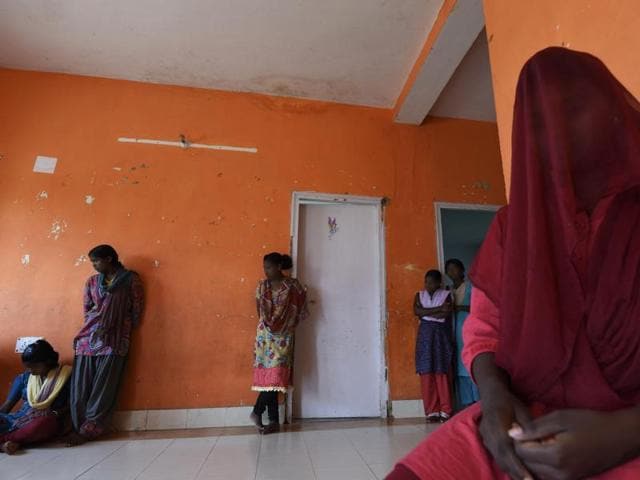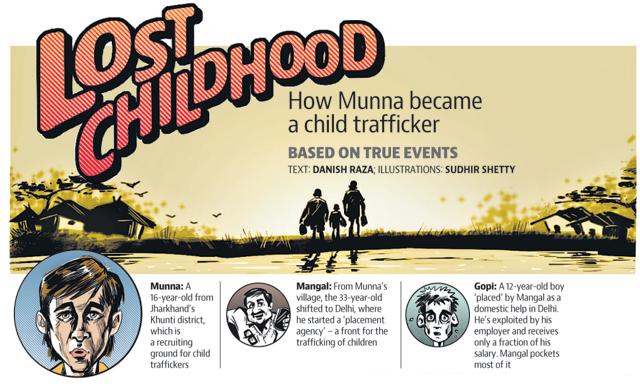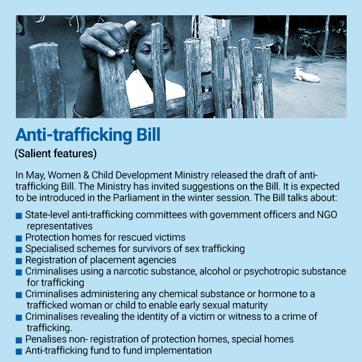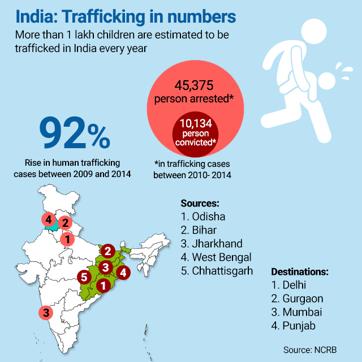‘Juvenile trafficker’: How human traffickers are training hundreds of minors in the job
As part of organised syndicates, juveniles in India’s poverty-stricken regions have been trafficking children to big cities
An investigation by Hindustan Times has revealed an emerging form of human trafficking, one which is falling through the cracks --seasoned traffickers using children in 16-18 age group in organised crime, training them to traffic younger kids from country’s poorest states to urban centers. For promised amount of Rs 5,000 to Rs 10,000 per child, minors on the cusp of adulthood, embark on this dangerous journey, in the hope of escaping endemic poverty.

Once they arrive in the urban centers, trafficked children are placed in various sectors: domestic work, brick kiln, sex work, agricultural labour and eateries.

Read | HT comic strip Lost childhood: How 16-year-old Munna became a child trafficker
The first-ever anti-human trafficking bill, introduced by Women and Child Development minister Maneka Gandhi in May, overlooks this issue.
“Traffickers keep looking for new ways to escape law. They are training kids because of two reasons. Children don’t raise suspicion. And if they are caught, they are tried under the Juvenile Justice Act (JJA) which is relatively lenient that the Indian Penal Code meant for adult offenders,” said Aradhana Singh, in-charge of Anti Human Trafficking Unit in Jharkhand’s Khunti district which has been supplying domestic help to thousands of homes in Delhi and satellite towns such as Noida, Gurgaon and Faridabad.
The IPC defines trafficking as recruiting, transporting, harbouring, or receiving person(s), by using threats or coercion, or deception, or power, for the purpose of exploitation.
The consent of the victim is immaterial in determination of the offence of trafficking.
As per data from National Crime Records Bureau (NCRB), the number of registered human trafficking cases increased by more than 38 per cent between 2009 and 2013.
LOST IN TRANSLATION
Based on interviews with trafficking survivors, members of various government institutions working for the welfare of minors, Anti- Human Trafficking Units, Railway Police and NGOs, Hindustan Times could confirm that more than 30 cases of children trafficking children have come to light in the last one year.
However, there is no centralised database of such cases as the current legal framework does not acknowledge ‘juvenile traffickers’. The focus of anti-human trafficking efforts is to catch middlemen or gang leaders who are adults.
“Every time we interact with kids, the priority is to inquire who are they working for and what is the scale of the operation. Details pertaining to masterminds become part of the database. This is one of the reasons why it is hard to get exact number of cases in which kids were used as traffickers,” said Singh.

Aparna Dwivedi, member of one of the three Child Welfare Committees in Delhi, has come across many cases which followed the pattern: an older child transporting children younger to him. In most of these cases, Dwivedi said, the elder child had in his custody, money, identity proof and tickets of younger ones. According to her, various teams of government bodies and NGOs working on the ground to curb human trafficking are unable to recognise this emerging form of trafficking because they are not sensitised enough.
“At railway stations when cops find that kids are travelling by themselves, they make a note of the same and hand over those kids to us. They do not probe the trafficking angle. If this angle emerges, they don’t lodge FIRs. This is why hundreds of trafficking cases remain undocumented,” she said.
THE TRAINING
It starts with a trip to a metro in search of better avenues. In a majority of the cases, a child’s distant relative or friend or acquaintance working in the big city doubles as a trafficker. With him, kids make the journey to the city voluntarily or involuntarily.
After reaching the urban centre, traffickers get hundreds of minors placed in various sectors. Minor girls, placed in prostitution, are sold many times over. But traffickers are always on a look out for children who can assist them. A tribal child who is smart and has spent three to six months in Delhi is seen as a potential recruit. The minor is trained to go back to the village to bring back more children.
“The outlook, things such as lipstick, mobile phone, and body language of girls who have returned from Delhi, appeal to girls in villages. They interact in local dialect about city life. The fact that a girl who was one of them has changed so much in a big city works as a magnate for village girls,” said Alakh Narayan Singh, member of the Child Welfare Committee in Jharkhand’s Gumla district.
How much money the ‘child trafficker’ gets depends on the age, looks and the sector in which the transported kids will be placed in. “If the girl who is brought to Delhi is beautiful and tribal, the child who brought her can get anything between Rs 10,000 to 50,000,” said Singh.

They try and keep changing their modus operandi to evade police.
Anil K Mishra, a lawyer from Bihar who has been working to curb human trafficking was part of a team that detained 12 kids in 2014 at Bihar’s Kaithal railway station. Hailing from Aharia and Kishanganj districts in Bihar, the kids were aboard Mahananda train to travel to Delhi. On realising that the kids were traveling by themselves, Mishra and his team mates asked them to get out of the train. On inquiring they found out that one of them was given the responsibility of taking others to Delhi. “That minor told me that next time he travelled in the train , he would appear busy working with a pen and notebook so that he looks like a student and does not catch people’s attention. I was quite surprised. It speaks volumes about the kind of training his employer would have given him on evading law,” said Mishra.
Rahul Mehta is the director of Ranchi chapter of Childline (an initiative of the Ministry of Women & Child Development, Department of Telecommunications and NGOs to work for cause of vulnerable children). Mehta said as part of the training, kids are told not to deboard the train in cities in which the Railway Police is active. “Instead of coming directly to railway stations in Delhi, they deboard the train at Anand Vihar, Nizamuddin and Ghaziabad,” he said.
CRIMINAL OR VICTIM?
Child rights experts are divided on whether to treat the ‘child trafficker’ as a victim or offender. The Juvenile Justice Act (JJA) has two broad categories for vulnerable children: children in need of care and protection and children in conflict with the law. Effectively, the former are considered victims and later, offenders.
In all the cases Hindustan Times examined, authorities treated kids who were found trafficking other kids, as children in need of care and protection. In some cases, they were let off after admonishment. In others, they were sent to shelter homes or reunited with their families.
“In such cases, the underage ‘trafficker’ will be treated as a victim. This is because he or she is not aware of the law- breaking aspect of the activity. If you say that it is about fixing accountability, we should also book parents,” said Mahavir Kaushik, former inspector with Delhi AHTU.
Enakshy Ganguly Thukral, co- director, HAQ centre for child rights, had a different opinion. “If the police has been treating them as children in need of care and protection, it is wrong. They should be treated as juveniles in conflict with the law. If the child is not made to realise that he was doing something illegal, there is a high possibility of him repeating the offence,” said Thukral. “If the same child is found smuggling drugs, authorities will treat him as an offender. Why not the same in case of human smuggling?” she added.
Legal action against trafficking in India is being taken under the IPC, Immoral Traffic Prevention Act, and Maharashtra Control of Organised Crime Act.
In 2011, the Juvenile Justice Board, Delhi, ruled that police could use MCOCA against adults who were using the juveniles in an organised manner.
The United Nations and the Union Ministry of Home Affairs describe trafficking as an organised crime. So far, there has not been a single case of police booking an adult for using children in trafficking- yet another example of laws failing to recognise changing dynamics of crime.





